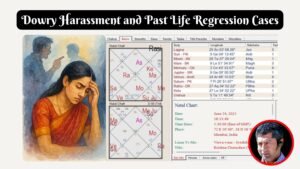Combining Varshaphal And Birth Charts By Gary Gomes
Article By Gary Gomes
Varshaphal charts are intended to give a microscopic viewpoint of the chart of the individual karmic pattern of the individual. Literally, Varshaphal means “fruit of the year”. The Varshaphal chart, at least as I was taught, was never intended to be a chart that was interpreted independently of the annual chart. As a matter of fact, the notable teacher from India, Dr. K.S. Charak, who lectured on Varshaphal and other Indian astrological techniques, insisted that the Varshaphal chart would never manifest anything that did not show in the natal chart.
If this is true, why even study the Varshaphal chart? First of all, similar to certain types of Jaimini systems, the Varshaphal reveals at an instant what the birth chart can only show through intensive analysis. The Varshaphal places a microscope over the entire chart and focuses all of the Jyotish elements in one year. Secondly, most classical Vedic systems use the Moon as the sole predictive indicator. The Varshaphal chart, refreshingly, takes certain perspectives from the Sun and/or like certain elements in Jaimini (the Jaimini Karakas) and other types of predictive systems contained within the Brihat Parasara Hora Sastra (specifically Karaka dasas), allows the degrees of the planets some role in when their effects will manifest. Finally, it allows individuals the perspective of judging a single year based upon a single starting point that is eminently recognizable to most individuals. To be quite honest, to the layman (and even to certain astrologers) the Jyotish system as it is currently practiced is quite complicated, and the timing of mahadasas by date is often very difficult to follow. Why not give the consumer of astrology a standard reference point, such as an overview of how their year will be?
The Varshaphal chart also charts the progress of the soul…where the Sun sits and how the person’s evolution is progressing. This is an important element to map in a person’s life.
Some Varshaphal Basics
Chart construction
The single easiest way to calculate a Varshaphal chart is the method specified in the Uttara Kalamrita. Essentially, one should just figure out the degrees and minutes at which the Sun sat when you were born, then figure out when the Sun will reach that same position during the year in question. Because degrees and minutes will be included in the calculation, one can estimate the lagna (the sign rising in the Eastern horizon as well. This can be calculated quite easily using an ephemeris for those who do not possess a computerized program. For those who have a computer program but who do not have a “Varshaphal” option, locating the sun placement is a bit of trial and error, but one can usually get the exact degrees and minutes, and this will produce the entire chart for you. Finally, the commercially available larger vedic astrology programs contain Varshaphal calculation and charts as installed options—just input the year you desire and you will be all set. One element of Varshaphal that is not being discussed here is sahams, as it deserves a separate write up.
Varga charts
Standard varga charts are calculated as they are in the birth chart for the year. Therefore, the sixteen standard varga charts are included in most Varshaphal calculations. These can be interpreted in the same way that the natal chart vargas are to be interpreted. In addition, there are several additional varga charts that are apparently derived from the Tajika (Varshaphal) system. The primary additional vargas that are introduced into Jyotish are:
The Panchamsa – the one-fifth divisional chart: Useful for matters connected to children, creativity, past-life credit, mantras and other related matters. This chart can be interpreted in the same way as a natal chart can be interpreted, but it yields the best results when one looks at the fifth house in this chart, Jupiter, Venus and the fifth lords in this chart, the varshaphal chart and the natal chart.
The Shastamsa – the one-sixth divisional chart: Useful for assessing health matters, enemies and obstacles. This chart should be analyzed by looking at the sixth house in this chart, Saturn, Mars, Ketu and Rahu, and the sixth house lords of this divisional, the varshaphal and natal charts. Spiritual Sadhana or service can also be assessed through this chart.
The Ashtamsa – the one-eighth divisional chart. This chart can be used to assess long-term obstacles in life, problems in relationships, hidden problems and even chronic illnesses (that could lead to death) for the individual. Again, one would look at the eighth house in this chart, Saturn, Mars, Rahu and Ketu and the lords of the eighth house in this chart, the birth chart and the annual chart.
The Ekadamsa – the one-eleventh divisional chart. The Ekadamsa chart is used to assess financial gains, friendships, status, and elder siblings. The factors to look at in this chart are the eleventh house in this chart; the eleventh lord in the natal chart, in the annual chart and in this chart, as well as Jupiter, Venus and Mars.
Muntha and Year Lord.
The Muntha is the progressed rising sign in the birth chart. This is used for determining the central focus of the year and is also considered when interpreting which planet should be ‘lord of the year’. The major idea behind the Muntha is that it is good when placed in a benefic house (such as the 1st, 2nd, 3rd, 5th, 9th, 10th, or 11th houses), difficult placed in the 4th, 6th, 7th, 8th, 12th houses.
(Please keep in mind that planets in the eighth and twelfth houses are not necessarily evil; in fact, they can produce surprising increases in status during their periods, especially if the individual is unselfish or engaged in some kind of spiritual practice or service.)
There are five planets that are considered office bearers in Varshaphal charts. These are the:
1) Muntha Pati or the lord of the sign in which the Muntha is placed
2) Janma Lagna Pati or the lord of the ascendant in the birth chart
3) Varsha lagna or the lord of the ascendant in the annual chart
4) Tri Rasi Pati or the lord of the Tri-Rasi (this changes from sign to sign according to whether the Varshapravesha rising sign occurs during the daytime or the nighttime.)
For Aries rising, the daytime Tri-Rasi Pati is the Sun; the nighttime is Jupiter.
For Taurus rising, the daytime Tri-Rasi Pati is Venus; the nighttime is Moon.
For Gemini rising, the daytime Tri-Rasi Pati is Saturn; the nighttime is Mercury.
For Cancer rising, the daytime Tri-Rasi Pati is the Venus; the nighttime is Mars.
For Leo rising, the daytime Tri-Rasi Pati is the Jupiter; the nighttime is the Sun.
For Virgo rising, the daytime Tri-Rasi Pati is the Moon; the nighttime is Venus.
For Libra rising, the daytime Tri-Rasi Pati is the Mercury; the nighttime is Saturn.
For Scorpio rising, the daytime Tri-Rasi Pati is Mars; the nighttime is Venus.
For Sagittarius rising, the daytime Tri-Rasi Pati is Saturn; the nighttime is Jupiter.
For Capricorn rising, the daytime Tri-Rasi Pati is Mars; the nighttime is Mars.
For Aquarius rising, the daytime Tri-Rasi Pati is the Jupiter; the nighttime is Jupiter.
For Pisces rising, the daytime Tri-Rasi Pati is the Moon; the nighttime is the Moon.
5) Dina-Ratri Pati or the lord of the Sun sign occurring during the daytime or the lord of the Moon sign if the Varshapravesha occurs at night.
The lord of the year should meet two essential qualifications.
- It must aspect the Varshaphal rising sign (Varshapravesha)
- It must be the strongest of the planets aspecting the lagna.
In cases where no office bearer aspects the rising sign, the Muntha lord automatically becomes the year lord. According to some sources, the Moon can never become the year lord. According to others, this restriction does not apply. Strength is determined from the status of the planets according to the Pancha-vargiya bala, a rather complicated system of assessing planetary strength. As the name implies, five factors are used:
3. Griha bala or Kshetra Bala – points assigned if a planet is in its own house. 30 points are the most given for a planet in its own sign. The low point is 7.5 for a planet in an enemy’s sign.
4. Uccha bala – as the name implies, points are given based upon how close a planet is to its exaltation sign. The most a planet can get for being at highest exaltation is 20 units; the least is zero (for deep debilitation). There are a series of calculations using degrees and minutes in order to calculate the points for planets between highest exaltation and lowest debilitation.
5. Hudda bala- a special feature of this system found nowhere else in Hindu astrology. Each sign is divided into five parts, each with its own hudda or leader (the Sun and Moon do not own any huddas). If a planet falls in its own Hudda, it gets 15 points (the most); in a friend’s Hudda, 11:15 points, in an enemy’s Hudda, 3:45 points. The calculations for this are actually a bit complicated and outside the realm of this article.
6. Drekkana Bala—This is a direct quote from Dr. K. S. Charak’s text, Varshaphala. “The Drekkana lords for the consideration of the Pancha-Vargiya bala is different from those in the Parashari system. Here the lord of the first drekkana in Aries is Mars. The lords of the first drekkana in the successive rashis are the planets that fall in regular order from Mars onwards (i.e. Mars, Mercury, Jupiter, Venus, Saturn, Sun, Moon, Mars, Mercury, Jupiter, Venus, and Saturn. Begin the second drekkana of Aries from the Sun and proceed in the same order. The cycle continues through the third drekkana of Aries, with its lord Venus, until the third drekkana of Pisces, whose lord happens to be Mars. This method of determining the Drekkana lord is only applicable to the Pancha-Vargiya Bala.” (p.59)
7. Navamsa bala—Unlike the drekkana bala indicated above, the Navamsa is calculated as in Parasari astrology, so lords of planets in their own signs receive 10 points and lords of planets in enemy signs receive 2.5 points, and planets in friend’s signs receive 7.5 points.
These are then tabulated and the planets with the most reduced points becomes the strongest planet.
Special Tajika Mahadasas
The Patyayini Dasa
I actually prefer this mahadasa to the standard mahadasas used in Vedic astrology, because it is NOT nakshatra-based and seems to be unique to every annual chart. In this system, the longitudes of the seven planets and the ascendant cusp, are recorded in signs, degrees and minutes. Like the chara karakas specified in the Brihat Parasara Hora Sastra, the signs are ignored and the remaining degrees, minutes (and seconds) are noted as the Krishamshas in ascending order. This ascending order determines the dasa order in the Patyayini system. So the planet (or ascendant) with the lowest number of degrees [in its sign] is the first dasa under this system.
The calculation of the length of the periods is judged in a different way. Starting with the planet that has the lowest number of degrees, this gets a patyamsha equal to its degrees in its sign. The degrees of the first planet are subtracted from the planet next highest in degree, and the difference between the two is the patyamsha of the next planet. The degrees of the second planet are then subtracted from the third planet in order to generate the next patyamsha, and so forth. After the patyamshas have been calculated, the duration of the periods is calculated using the following formula to calculate the number of days in each period:
Take 365 days times the Patyamsha (of the planet in question) divided by the highest degree value (also called the Krishamsha value) of the planets in question.
This formula will render the days for each sub-period. The antardasas are calculated by taking the same proportion of time for a dasa as they do for an entire year.
Mudda Dasa
This mahadasa might be more appealing for those used to the Vimshottari mahadasa system. In order to calculate the mudda dasa, do the following.
- Take the number of years of life completed. Add to this the nakshatra number at birth. If it is Krittika, for example, add three), then subtract two (the number 2), then divide this by 9. Ignore the quotient. The remainder gives the dasa operating that year. A remainder of 1 would give the Sun; 2 the Moon; 3 Mars; 4 Rahu; 5 Jupiter; 6 Saturn; 7 Mercury; 8 Ketu; 0 Venus. In other words, the normal Vimshottari sequence compressed into a year starting with a lunar position progressed by one Nakshatra a year.
- In order to calculate the balance of the dasa, use the balance of the birth dasa. The remainder of the birth dasa period will be the same as the balance of the birth dasa percentage as contained in your natal chart. As a result of the method, the mahadasa of the year is almost invariably the one after the one that the previous year ended with. Of course, the new year does have different planetary positions, so there will often be major change from one year to the next.
Alternate Mudda Dasa
According to the Utttara Kalamrita , one of my favorite Jyotish texts, one can take the dasa lord of the annual chart’s Moon nakshatra as being the starting mahadasa in the annual chart. The simplicity of this approach appeals to me, and I have found that it gives extremely good results. (I have used a similar technique in determining the timing of prashna charts.)
Which Dasa?
Take your pick. By far the most interesting thing that I have noticed about Jyotish is that different modalities of prediction work consistently well if one uses the same reference base. Transposing a 360-day system on top of a 365-day system will not produce similar results, but using two 365-day systems (or two 360 day systems) will
Can one use other dasas on the Varshaphal chart?
In my opinion, yes. Dr. Charak had said he good results when he used the Yogini mahadasa system a few years ago (whatever happened to the interest in Yogini?) and I have experimented with compressed (one year) Jaimini Chara dasa and Kalachakra dasa systems to good effect, so long as one follows the interpretational rules contained in each system.
Yogas in Varshaphal
The use of yogas has always seemed to be a bit suspect to me, as I think you can garner the same results by careful chart analysis as one can from yogas, but there are special yogas in the Varshaphal system. I would like to mention the two most important, as these tend to show very good results when interpreting these charts.
The Ithasala Yoga. This occurs when a faster moving planet is behind a slower moving one and will “catch up” to the slower moving planet by aspect or conjunction. There are special conditions attached to this yoga, and if any of the conditions fail to manifest, the yoga will not fructify. Retrograde motion will cancel the yoga, for example, and planets must be in their “orbs of influence” for the yoga to work. If it does fructify, it is a yoga of good fortune. Because of all of the conditions that can spoil an ithisala yoga or its variants, a true un-spoilt ithisala is pretty rare.
Ishrafa Yoga is a separating yoga, occurring when a faster moving planet is moving away from a slower one. This is considered a combination for misfortune.
Most of the Varshaphal Yogas are variations on these two combinations. It is also acceptable to use Parashari Yogas in the Varshaphal system.
Special Condition in the Varshaphal Chart
A year in which the rising sign for the Varshaphal chart is the same as the birth chart rising sign is considered a difficult year for the person whose chart is being analyzed. There will either be personal injury or loss of money during this year.
Combining the Natal Chart and the Annual Chart—Tried Techniques
One of the more obvious techniques that can be used for comparing the two charts is to compare the rising sign house for the Varshaphal Year with that of the rising sign for the natal chart. If the rising sign of the Varshaphal chart is the 2nd house, it will show a focus on money, in the fifth house an increase of focus on children; if in the seventh house it will show a focus on
marriage. If in the ninth or eleventh houses, it will show an emphasis on status or luck. So this is the first step one should take in analyzing a Varshaphal chart compared with a natal chart. Next, check the Muntha point in the chart.
The second step is to look at the changeable karakas, such as the Atma Karaka in the birth chart and check its location in the Varshaphal chart. If the Atma Karaka planet is well placed in the Varshaphal chart, the year will be beneficial to the native, if it is badly placed, then luck and personal health will be adversely affected. Go down the list. Check the Amatya Karaka (career indicator) next; then the Bhatri Karaka (desires, skills and brothers); Matri Karaka (mother, education, status) next; Pitri/Putri Karaka (children, creativity, intelligence, father); Gnati Karaka (service, illness, servants); Dara Karaka (wife, partnerships).
These planets are the planets in the highest to lowest degree in the birth chart. You can also check the planets that assume these positions in the Varshaphal chart. These karakas in the varshaphal chart are not quite as strong as they are in the natal chart however. But, if these karakas are the same planets in both the birth and Varshaphal charts, the strength of these planets for producing good and bad effects, according to their significations, are extremely strong.
The other thing you want to look for is the placement of the planets in the Varshaphal chart in relation to the natal chart. If you want to get practical about it, the birth chart is a transit chart for the time that a person is born; the Varshaphal chart is essentially a transit chart of the year in question. Is Jupiter transiting a good position in the natal chart; is Saturn, the Nodes or Mars? Some Sun signs are very sensitive every year to transits from the inner planets; for example, those with Virgo suns will often have debilitated Venuses and exalted Mercury’s in a Varshaphal chart; those with Pisces or Aquarius suns are prone to debilitated Mercury’s and exalted Venus. The Capricorn and Cancer axis has similar situations with strong and weak Mars, for example. These all have to be factored in when analyzing the chart.
In analyzing the chart, I would start with the birth chart. The Varshaphal is an ancillary chart that should not be interpreted in isolation from the birth chart. The major thing to keep in mind is that the birth chart should be analyzed in the standard manner, utilizing a standard analysis of the birth chart, including the Parasari aspects, dasas, and harmonic charts.
There are no real shortcuts to analyzing dasas. However when you analyze the Vimshottari Mahadasa — or whichever Mahadasas you use; I would recommend the Yogini and Tribhagi (a compressed Vimshottari system) if you are partial to nakshatra-based dasas, as these can be used for general purposes or the Chara dasa introduced by K.N. Rao as accurate systems. Look for the relationship of the Mahadasa lords to each other and their position in the charts as strong or weak, natural benefics or malefics, or as benefic or malefic lords of the chart. There should also be an analysis of the varga charts for in-depth analysis of the date presented.
When you do this, and get a general feel for whether the period will be benefic or malefic, then look at the Varshaphal chart. When you analyze the dasas, you will notice that these are easier to analyze than the birth chart mahadasas because they will manifest within a year’s time. Also, you should keep in mind the principle of applying (ithisala) and separating (ishrafa) aspects as you are reviewing the charts.
In the patyayini mahadasa system you will see the year lord giving very strong and positive results according to where it is placed in the chart. I always check at least this and the mudda dasa results for the year before I pronounce a final judgment upon a year chart. Also, short-term transits of the planets (like a retrograde Mercury or a debilitated Venus or Mars) can produce very telling results on a short-term basis that may not show up in any of the charts! I would look for these in assessing moods of individuals.
I have not covered other special features of Varshaphal, such as the use of Sahams (degrees in the chart that are derived by adding and subtracting certain planets and houses in the Varshaphal chart and also in the natal chart; these produce points in the chart that concern prosperity, knowledge (or Guru), strife, disease and other matters. They have found a home in Western astrology in the form of the Arabic Parts. I have found that Sahams tend to work, but not consistently, implying that many conditions must be met for these points to work properly—but the standard natal chart guidelines I have given above do produce the desired for results; perhaps the sahams are refining points rather than key factors in annual chart interpretation.
In any event, Varshaphal is a fascinating system but is not typically a quick study—it took me a couple of years to get results that I could identify as reliable and consistent—but it is, as said before, a great interpretative tool and a laser beam to accuracy in the year ahead.












Leave a reply
You must be logged in to post a comment.